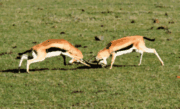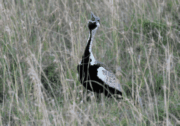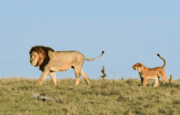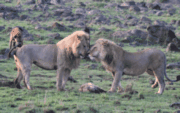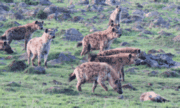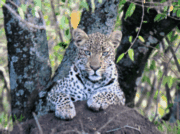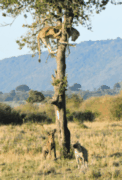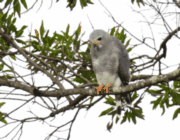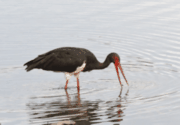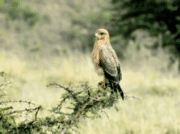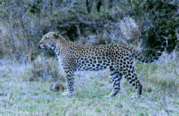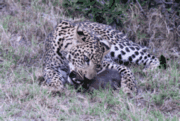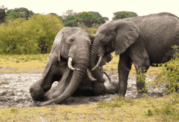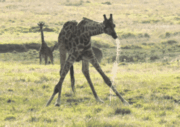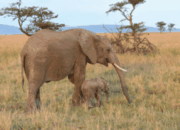|
Mike Mockler Kenya |
Kenya Private Tour, November 2022 Flying into the conservancies by light aircraft is always exciting, with our anticipation mounting as the landscape below changes from cultivated land to wild bush country. This time our emotions were running even higher than usual after three years’ absence caused by Covid-19. As our Cessna approached the small airstrip, the plains below were gleaming with fresh green grass and grazing wildebeest, zebras and gazelles were clearly visible from the air. The Mara Conservancies, stretching away in all directions, looked absolutely stunning. These conservancies, where we would be staying, are very different from the famous Masai Mara Game Reserve nearby. They have far fewer visitors (and therefore fewer vehicles) and our accommodation would be delightful, small, exclusive tented camps in lovely locations. Recent rains had prompted multiple births: there were delicate baby impalas, comical little warthog piglets and frisky young topis. Adult male Tomson’s gazelles were jousting furiously and locking horns, fired up by the rain and fresh, lush grass. Other mammals with new-born young included buffalo, eland, zebra, wildebeest and giraffe. Birds were singing and displaying: larks, longclaws and orioles, as well as Black-bellied Bustards, White-bellied Bustards and magnificent Kori Bustards. Later in the tour, we would enjoy no fewer than 12 leopard sightings involving 8 different leopards. We would see several cheetahs too and many lions would be encountered daily with a total of more than 100 lions seen, many with cubs of different sizes. As our safari progressed, we enjoyed so many highlights it’s difficult to recall all of them but one morning was truly unforgettable. It began when a dramatic battle flared up among more than 60 hyenas from rival clans. Their incredibly loud, whooping calls attracted two big male lions who strode in among the hyenas, roaring at them, pushing the noise levels way off the scale. One of the male lions immediately attacked and killed a sub-adult hyena, then stood over it, glaring at the massed ranks of hyenas facing him. “That’s what I’ll do to you!” was the clear message. The two males congratulated each other by mutually grooming and nuzzling each other’s faces before strolling off to nearby woodland. We assumed that was the end of the drama but it wasn’t. We had previously noticed a young male leopard watching the whole sequence of events from a croton thicket. Now he attacked a female warthog, which fled with one of her piglets straight into the clearing where the two male lions had just settled down. One of the lions promptly leapt to his feet, grabbed the piglet and ran off with it in his mouth, chased by the other male who wanted the piglet for himself! We returned to the croton thicket to see if the young male leopard was still there and to check he was safe. He was and we photographed him relaxing on a termite mound. Finally, we drove away from the scene. Surely that was the end of these extraordinary events but we immediately came upon a cheetah mother with two large cubs. The cubs, frustrated by ever-present jackals trying to steal their kills, attacked two jackals and chased them into the distance, snapping at their tails as they raced after them. It had been a breath-taking morning. I steer clear of Kenya’s overcrowded National Parks and National Reserves, concentrating instead on the best private conservancies - admittedly more expensive but infinitely more rewarding, with wonderful wildlife-viewing and extraordinary events such as those I have just recounted. In fact, just two days later, in virtually the same location, we witnessed yet another remarkable spectacle. A mob of hyenas ganged up on a solitary lioness and terrorised her until she fled in panic and clambered up a thin, spindly tree which wasn’t at all suitable for a cat of her weight. She clung on awkwardly and uncomfortably for some time until, eventually, her tormentors lost interest and drifted away. She then had to work out a way to get back down safely! It took her some time but she managed to clamber backwards down the trunk and alighted on the ground, her dignity just about intact. As usual, birds were everywhere and birdwatching was brilliant at all times, with resident species being joined by migrants arriving from the north in their hundreds of thousands. We enjoyed excellent views of no fewer than 10 species of eagle plus 23 other kinds of raptor which included scarce species such as Pallid Harrier, Montagu’s Harrier, Grey Kestrel and Lizard Buzzard. We even saw (and photographed) a Grasshopper Buzzard, a species that we had never encountered before and is rarely seen in this part of East Africa. With bright rufous wings, it is an attractive and distinctive bird. We had sightings of 21 species of herons, storks and related species including Abdim’s Storks, Black Storks and over 300 migrating White Storks initially resting by a water-hole then soaring upwards, searching for a thermal to help them on their epic journey. The continual flow of migrating birds coming from the north and heading further south was staggering: Barn Swallows, parties of Common Swifts, Eurasian Rollers, European Bee-eaters, Steppe Eagles, wheatears and many more ….. We have known a beautiful female leopard since February 2014 when she hid her first litter, two tiny bundles of fur with milky blue eyes, in thick vegetation within our camp. Our paths have crossed with hers on many occasions since then and this time we found her resting in a deep, overgrown gully where small birds such as Rattling Cisticolas and Purple Grenadiers revealed her position with their alarm calls. We expected her to remain in the vicinity as she had a 9-month-old male cub so we returned two days later and enjoyed a wonderful afternoon with mother and son. The son was feeding on a warthog piglet which his mother had cached in a tree for him to retrieve and she climbed another tree where she had hidden a large monitor lizard that she had killed and began eating it. However, the son, having finished the baby warthog, now joined his mother on a high branch of the tree, forcing his way underneath her and between her legs so he could steal her monitor lizard. She was definitely not amused and showed her displeasure by baring her teeth with a snarl but soon she gave way, as mothers do. Giraffes are always lovely to watch, with their leisurely, elegant way of walking and an endearing habit of standing and staring at you with a surprised and deeply puzzled look. Drinking at water-holes, with their legs widely spread, is not without its problems - and potential dangers should they be attacked by lions. We spent a long time watching a small herd drinking, amused by the way they sprayed water in all directions each time they lifted their heads. We also had many enjoyable encounters with elephants too, including an entertaining occasion when we watched three bull elephants rolling around ecstatically in a large mud wallow. There was no mistaking their absolute delight. On our last day, a breeding herd of elephants was browsing peacefully when we found them. Having seen nervous and aggressive elephants in other African countries, I’m always amazed at how confiding and relaxed the elephants are in the Mara conservancies. Fortunately, they have never experienced poaching or commercial trophy-hunters so they have nothing to fear when we are near them. In fact they usually ignore game-viewing vehicles completely (as long as the occupants remain quiet) and on this occasion the entire herd grazed and browsed quietly around us, often within touching distance of our vehicle. It was a pleasure and an honour to be surrounded by these intelligent, gentle giants. It’s worth pointing out that only one African country has, for many years, had a total ban on all commercial big-game hunting. And which country is that? Yes, you’ve guessed it. It’s Kenya!
|
|
